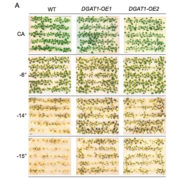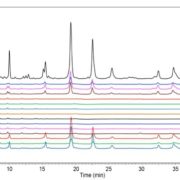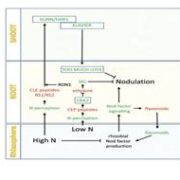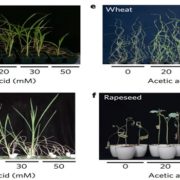Review: Isoprene research – 60 years later, the biology is still enigmatic ($)
 Sixty years ago, the first report of isoprene (C5H8; 2-methyl-1,3-butadiene) emissions from plants was published. Isoprenes are the largest source of non-methane hydrocarbons in Earth’s atmosphere; furthermore, isoprene is reactive in atmospheric chemistry and can be converted into a variety of harmful compounds. Sharkey and Monson provide a historical overview of the development of our understanding of the role and significance of isoprene emissions to plant biology, and highlight areas where uncertainty remains. For example, although light and temperature are correlated with isoprene emission, emission is also affected by long-term growth conditions and stimulated by change. Furthermore, although it is generally true that isoprene can confer protection against abiotic stresses, the relationship does not always hold, and debate continues about the mechanism for such protection. As yet, we don’t know enough to accurately predict which species will be isoprene emitters (about 20% of perennial plants emit isoprenes), nor the timing and amount of isoprene emissions, nor how global change will impact isoprene emissions. Although much has been learned in the past 60 years, “the biology is still enigmatic”. Plant Cell Environ. 10.1111/pce.12930
Sixty years ago, the first report of isoprene (C5H8; 2-methyl-1,3-butadiene) emissions from plants was published. Isoprenes are the largest source of non-methane hydrocarbons in Earth’s atmosphere; furthermore, isoprene is reactive in atmospheric chemistry and can be converted into a variety of harmful compounds. Sharkey and Monson provide a historical overview of the development of our understanding of the role and significance of isoprene emissions to plant biology, and highlight areas where uncertainty remains. For example, although light and temperature are correlated with isoprene emission, emission is also affected by long-term growth conditions and stimulated by change. Furthermore, although it is generally true that isoprene can confer protection against abiotic stresses, the relationship does not always hold, and debate continues about the mechanism for such protection. As yet, we don’t know enough to accurately predict which species will be isoprene emitters (about 20% of perennial plants emit isoprenes), nor the timing and amount of isoprene emissions, nor how global change will impact isoprene emissions. Although much has been learned in the past 60 years, “the biology is still enigmatic”. Plant Cell Environ. 10.1111/pce.12930










Leave a Reply
Want to join the discussion?Feel free to contribute!